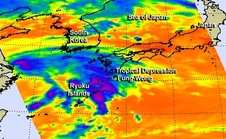NASA Sees the End of Post- Depression Fung-Wong

NASA's Aqua satellite passed over Tropical Depression Fung-Wong on Sept. 23 at 12:23 a.m. EDT and the storm resembled a frontal system more than a depression. Image Credit: NASA JPL, Ed Olsen
NASA's Aqua satellite passed over Tropical Depression Fung-Wong on Sept. 23 at 12:23 a.m. EDT.
The Atmospheric Infrared Sounder or AIRS instrument that flies aboard Aqua gathered infrared temperature data on the storm's clouds.
The data was false-colored at NASA's Jet Propulsion Laboratory, Pasadena, California and showed that the storm resembled a frontal system more than a depression.
The center of circulation was southwest of the bulk of thunderstorms and showers, which resembled a curved front. The strongest thunderstorms had cloud-top temperatures near -63F/-53C, and were over Japan's northern Ryuku Islands.
The Joint Typhoon Warning Center issued the final bulletin on Fung-Wong on Sept. 23 at 1500 UTC (11 a.m. EDT) when it was centered about 351 miles west of Sasebo, Japan, near 32.4 north latitude and 122.8 east longitude.
At the time, the depression had maximum sustained winds near 30 knots (34.5 mph/55.5 kph). It was moving to the northeast at 11 knots (12.6 mph/20.3 kph).
On Sept. 24, the remnants of Fung-Wong, now an extra-tropical storm continued moving to the northeast and into the tropical cyclone history books.
Rob Gutro
NASA's Goddard Space Flight Center
Media Contact
More Information:
http://www.nasa.gov/content/goddard/tropical-depression-16w-nw-pacific/All latest news from the category: Earth Sciences
Earth Sciences (also referred to as Geosciences), which deals with basic issues surrounding our planet, plays a vital role in the area of energy and raw materials supply.
Earth Sciences comprises subjects such as geology, geography, geological informatics, paleontology, mineralogy, petrography, crystallography, geophysics, geodesy, glaciology, cartography, photogrammetry, meteorology and seismology, early-warning systems, earthquake research and polar research.
Newest articles

“Nanostitches” enable lighter and tougher composite materials
In research that may lead to next-generation airplanes and spacecraft, MIT engineers used carbon nanotubes to prevent cracking in multilayered composites. To save on fuel and reduce aircraft emissions, engineers…

Trash to treasure
Researchers turn metal waste into catalyst for hydrogen. Scientists have found a way to transform metal waste into a highly efficient catalyst to make hydrogen from water, a discovery that…

Real-time detection of infectious disease viruses
… by searching for molecular fingerprinting. A research team consisting of Professor Kyoung-Duck Park and Taeyoung Moon and Huitae Joo, PhD candidates, from the Department of Physics at Pohang University…




















